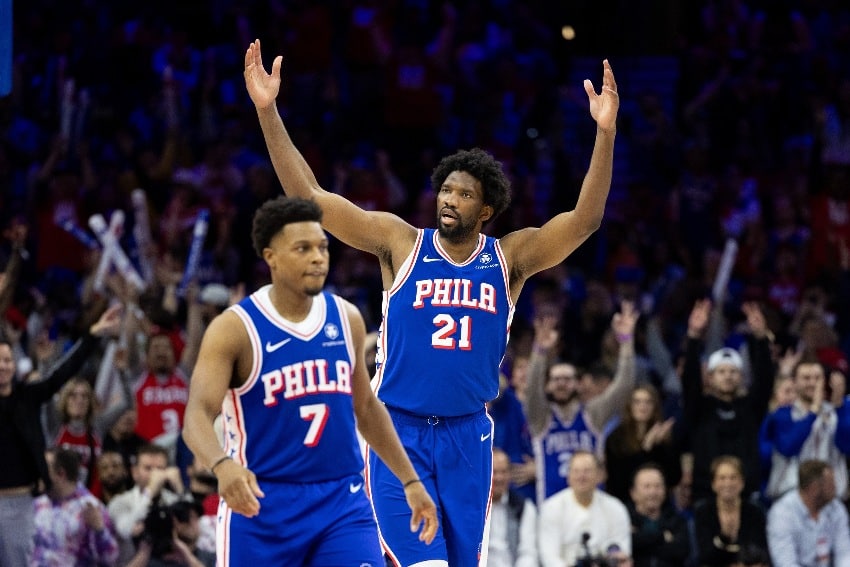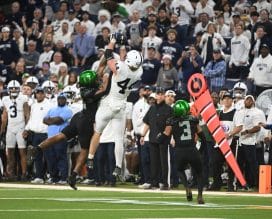Sixers
How One Play Unlocked The Sixers’ Offense In Game 3

Early in the first quarter of Thursday’s Game 3 between the New York Knicks and Philadelphia 76ers, Kyle Lowry stood parallel to his MVP center and perpendicular to his rising star running mate. The pugnacious point guard seemed ready to set a screen for Tyrese Maxey, with Joel Embiid nearby, stationed atop the arc, providing a second screen if the scintillating speedster required one.
Instead, Maxey waved off Lowry, directed him to the corner and sauntered around Embiid’s pick into a stepback 3, which skipped off the front rim, bounced off the backboard and into Donte DiVicenzo’s clutches.
An hour later, there would be no waving off of Lowry from Maxey. Such an audible didn’t make sense, given how the three of them repeatedly carved up New York’s defense during a blistering third quarter. Together, they tallied 33 of Philadelphia’s 43 points in the frame, dished out 10 assists, and combined to shoot 13 of 17 from the floor.
That third quarter salvaged the Sixers’ season. They spun a 58-55 halftime deficit into a 98-85 lead and kept the Knicks at bay in the fourth for a 125-114 victory, bringing this first-round series to 2-1 rather than 3-0 — a historically damning hole, despite the Boston Celtics’ fiercest efforts to buck that trend a year ago.
Philadelphia’s 204.8 offensive rating in that period wasn’t just its highest offensive rating for any quarter this series, it was the gaudiest offensive rating for any team in any quarter throughout these playoffs.
The Sixers drilled 17 of their 22 shots, went 9 of 12 beyond the arc and didn’t record a single turnover. Across a 12-possession stretch, they scored 11 times, including seven consecutive baskets. They converted on 12 of their final 14 trips and only failed to score four times on 21 total possessions.
At the most crucial of junctures, it was a clinical performance, largely driven by one action. It’s the same action Maxey previously opted out of in favor of a standard ball-screen with Embiid — a sign of swaying tides and how this game would eventually be won.
Early in the third quarter, the Sixers dialed up 77 Empty with Maxey initiating, Lowry screening then leaking to the empty corner and Embiid primed as the second screener. Over the next 6.5 minutes, they ran it nine times and generated eight shots from it (the Knicks committed a non-shooting foul once). They scored 17 points on those plays, good for 2.1 points per possession.
All series, Philadelphia’s utilized Lowry as an on- and off-ball pick man to highlight his screening and shooting chops. He’s long excelled setting burly screens before flowing into a movement jumper or snappy decision off the catch. Lowry’s inclusion also involves Jalen Brunson, who’s a brilliant player, but one with significant defensive limitations and has been assigned to Lowry throughout much of these three games.
Since the corner is emptied, a show from Brunson rather than a switch runs the risk of gifting Lowry — a 39 percent long-range shooter this season — open threes or space to drive inside, thrusting New York’s defense into a scramble against a player who relishes those opportunities.
“[The Knicks] are very good defensively. If you don’t get some of that, they’re gonna be glued to you,” Sixers head coach Nick Nurse told reporters of Lowry’s screening following Game 3.“So even if it’s just a quarter of a hit, or half a hit, it gives us a little freedom to run with some pace.”
I asked Nurse about the importance of using Kyle Lowry as a screener:
“They’re very good defensively. If you don’t get some of that, they’re gonna be glued to you. So even if it’s just a quarter of a hit, or half a hit, it gives us a little freedom to run with some pace.” pic.twitter.com/ZdMuXYcxzs
— Daniel Olinger (@dan_olinger) April 26, 2024
On the first installation of 77 Empty, Brunson switched onto Maxey, who unfurled a bouncy stepback triple over him, with Brunson’s size and lateral quickness rendering him unable to properly contest the jumper.
A few possessions later, New York again concedes the switch of Brunson onto Maxey. This time, Brunson sits on Maxey’s right hip and directs him into help. Maxey briefly hits the accelerator and coaxes Isaiah Hartenstein toward him. With Brunson funneling Maxey left, Josh Hart rotates early as the low man against a potential drive and DiVincenzo is conflicted about where to be. Maxey instantly scans the court and slings an easy pocket pass to Embiid for his rhythm midrange jumper.
The following possession, Maxey sees Brunson sitting back, rejects the screen, demands Brunson defend him and wiggles inside, yet leaves the layup short. It’s an excellent process the Sixers were presumably content with, especially since it didn’t deter them from going back to the well.
After a short sabbatical and the Sixers now sporting a five-point lead, they return to their pet play. Brunson is no longer switching, while OG Anunoby is prepared for Maxey to try and reject the screen. So, Lowry slips to the wing and Brunson hints at help toward Maxey, who swings the ball to his backcourt partner. A shot fake jolts Brunson off his feet, Lowry drives, draws rotations from Hart and Hartenstein, and feeds Embiid for the spot-up three.
At this point, Philadelphia’s established some offensive rhythm that had largely escaped it in the series. It’s not that the offense was horrendous through two games, but rather so much of the success stemmed from Maxey’s individual prowess, Embiid’s fortitude or the occasional role player contribution. A consistent, reliable formula didn’t define most of the productive offense before then.
Now, 77 Empty is loosening the tension of New York’s imposing, smash-in-your-teeth defense. There’s a flow and an identity derived from the two stars. This time, Maxey loops around both screens and lures the priority of Anunoby and Hartenstein, while Embiid pops up top and Lowry drifts to the wing/corner.
Left with two options, Brunson is torn. Maxey sees this. He watches Lowry’s glacial movement slowly pull Brunson toward him and snaps a behind-the-back feed to Embiid, who is unbothered by Brunson’s stunt and buries the long ball.
One of the most evident areas of growth for Maxey this season has been his timing. He leverages his speed and command of the offense as a scorer and playmaker in refined ways. Once a dynamite secondary scorer who could moonlight at point guard, he’s become a bona fide floor general. It was on display there.
As the Knicks and Sixers trade buckets, keeping New York within a competitive distance, 77 Empty continues to be the standard operating procedure. Maxey takes the first screen and sees a chance to hunt Brunson on an island. But Brunson pressures his counterpart and diverts him away from the empty side.
For the first time all quarter, it seems like the Knicks have actually contained this action. Then, Embiid rises over Hartenstein and dots the wing triple. Sometimes, star shot-makers do that. All the quality looks Philadelphia sparked prior gave it some wiggle room to rely on individual mastery.
The Knicks match Embiid’s bucket with a Hart three-ball. Maxey meanders over both screens. Anunoby and Hartenstein follow him. Brunson sticks to Embiid, who’s netted triples on three straight trips. Maxey spots the mismatch and suggests he’s about to wind another behind-the-back pass to the big fella, which rockets Anunoby into the air, hoping to deflect or deter the decision.
Anunoby’s pogo-stick positioning opens a lane downhill for Maxey, who lofts a cross-court kickout to Lowry for the spot-up snipe.
Finally, New York amends the matchups. DiVincenzo shifts to Lowry and Brunson takes Kelly Oubre Jr. DiVincenzo lunges out and applies pressure on Maxey. Then, he switches the pick-and-pop to wrangle with Embiid. Hartenstein brings help when Embiid catches the ball, invites a pass and Maxey misfires on the deep, albeit somewhat open, three.
Next time, with the Knicks down just five, Philadelphia calls timeout, Lowry exits for Cameron Payne and the offensive fireworks of 77 Empty call it a night (the Sixers still scored 13 points the next three minutes before the third wrapped up).
Game 3’s third quarter for Philadelphia was akin to Game 1’s second quarter for New York. In Game 1, the Knicks walloped the Sixers, 33-12, in the second quarter and lost the other three quarters, 92-90. In Game 3, the Sixers walloped the Knicks, 43-25, in the third quarter and lost the other three quarters, 87-82.
Those quarters are the difference between a confident 2-1 series lead for Philadelphia and a killshot 3-0 lead for New York. But the playoffs aren’t measured by how many quarters a team wins; the final score does not count footnotes.
The Sixers were irrevocably better than the Knicks in Game 3’s third quarter, just as the Knicks were irrevocably better than the Sixers in Game 1’s second quarter. For Philadelphia, a singular set and its multitudes kept the season alive, propelling these teams to a pivotal Game 4. Much like Saturday and Thursday, it’s one that could be determined by an isolated quarter of effervescent hoops and completely shape (or reshape) the outlook of this series.





